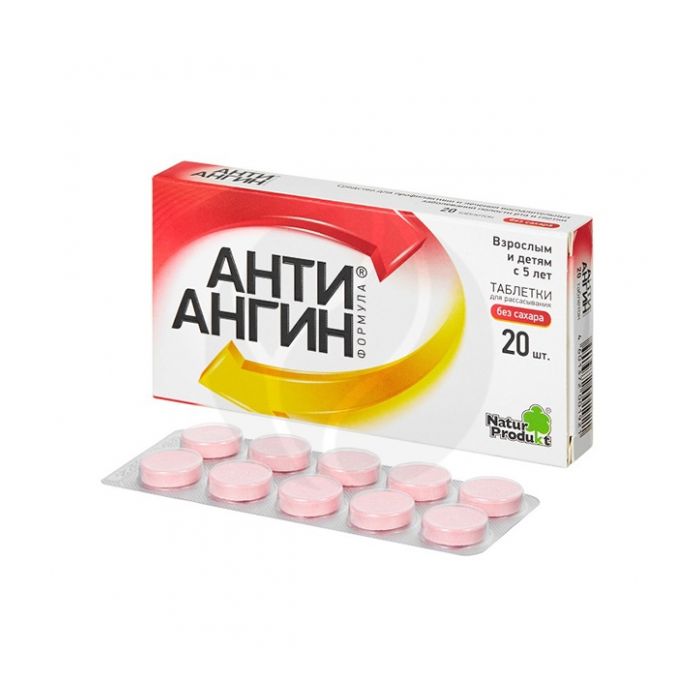Anti-angina formula tablets for resorption, No. 20
Expiration Date: 05/2027
Russian Pharmacy name:
Анти-ангин формула таблетки для рассасывания, №20
The drug is used topically. The tablets should be kept in the mouth until they are completely absorbed.
Adults and children from 15 years old - 6 tablets / day with an interval of 2 hours; children aged 10 to 15 years - 4 tablets / day with an interval of 3 hours; children aged 5 to 10 years - 3 tablets / day with an interval of 4 hours.
Lozenges are flat, with a beveled edge, from pale pink to reddish-pink in color with lighter and darker blotches, with a specific odor; both sides of the tablet are engraved with 'NP' on wood.
1 tab.
chlorhexidine diacetate 2 mg
tetracaine hydrochloride 0.2 mg
ascorbic acid 50 mg
Excipients: levomenthol, saccharin, sorbitol, silicon dioxide, magnesium stearate, anise flavor, mint flavor, azorubin dye (E122).
Children under 5 years of age;
I trimester of pregnancy;
hypersensitivity to the components of the drug.
With care: in the II and III trimesters of pregnancy as prescribed by a doctor, lactation period, with diabetes mellitus, glucose-6-phosphate dehydrogenase deficiency, hemochromatosis, sideroblastic anemia, thalassemia, hyperoxaluria, oxalosis and kidney stones.
pharmachologic effect
The antibacterial effect of chlorhexidine is due to non-specific binding to phospholipids of bacterial cell membranes. Chlorhexidine has a bactericidal and bacteriostatic effect, mainly against gram-positive bacteria and Candida albicans, and to a lesser extent against gram-negative bacteria. Chlorhexidine is especially active against Streptococcus mutans, Streptococcus salivarius, Escherichia coli, Selenomonas spp. and anaerobic bacteria. The drug is much less effective against such types of microorganisms as Streptococcus sanguis, Proteus, Pseudomonas, Klebsiella spp., Veillonella spp.
The anesthetic tetracaine has a local anesthetic effect.
Ascorbic acid is a cofactor in the process of collagen synthesis and tissue regeneration, enhances immune responses and reduces capillary permeability, thereby helping to reduce inflammation and edema of the mucous membranes of the oral cavity and pharynx.
Side effect
Allergic reactions are possible.
Heavy consumption can damage the tooth enamel.
Application during pregnancy and lactation
The use of the drug in the first trimester of pregnancy is contraindicated. The drug should be used with caution in the II and III trimesters, as well as during lactation.
Application for impaired renal function
The drug should be used with caution in hyperoxaluria, oxalosis and nephrolithiasis.
Application in children
Contraindicated in children under 5 years of age.
special instructions
It is not recommended to use simultaneously with preparations for the treatment of the oral cavity and pharynx containing iodine (Lugol's solution, povidone-iodine).
Ascorbic acid, which is part of the drug, can change the results of some laboratory tests, which should be reported during the tests.
Overdose
Symptoms: dizziness, general weakness, cyanosis, agitation, anxiety, muscle tremors, respiratory failure, nausea, vomiting.
Treatment: gastric lavage, the appointment of saline laxatives; symptomatic therapy.
Drug interactions
Tetracaine reduces the antibacterial activity of sulfa drugs.
Vasoconstrictor agents prolong the effect and reduce the toxicity of tetracaine.
Ascorbic acid increases the blood concentration of benzylpenicillin and tetracyclines, increases the risk of crystalluria during treatment with short-acting salicylates and sulfonamides, and reduces the blood concentration of oral contraceptives.

